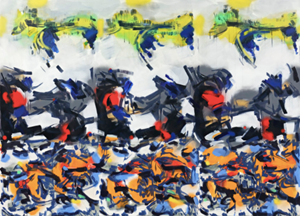
"My project Unfinished is the first true partnership between a painter and artificial intelligence. At the core of the project is a neural network that was fed with my paintings. The system analysed all facets of my art and learned how to generate an infinite number of unique images. The images supplied me with new compositions, perspectives, and themes".
Image: Roman Lipski, Unfinished 5, 2017, 150 cm x 210 cm, acrylic on canvas, photo credits Hans Georg Gaul
Artists like Roman Lipski claim the opportunity to push the boundaries of art with Artificial Intelligence. Rarely have the artist been faced with challenges like today's virtual reality and artificial intelligence.
Let’s explain which new technologies are disruptive
The Google Arts Project (GAP), developed by the Google Cultural Institute, has been collecting images of works of art for years to train its image recognition systems.
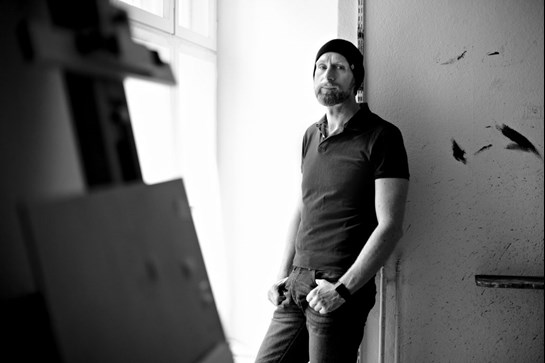 Roman Lipski, Photo by Hannes M. Meier
Roman Lipski, Photo by Hannes M. Meier
The MOMA of New York has contributed 30,000 archival images of its exhibitions since 1929 and 60,000 photographs of works of art from its collections; other museums follow.
Recently, the Machine-Learning Algorithms (MLA), having been trained on millions of images, do it as well as the man.
They need only a few human corrections. The Artificial Intelligence (AI) of these machines itself corrects its algorithms without human intervention.
The Google-Blog app features a wide variety of searches that anyone can experiment on their computer.
Art Palette selects a palette of colours throughout the history of art. Vincent van Gogh's 'Iris' are in the same colours as Monet's 'Nymphaea'.
On the basis of other portrait paintings by Rembrandt van Rijn, the IA has created a new Rembrandt painting, entirely invented. Anyone who thinks he or she is an artist can take a 3-D photo of an object or a head before transferring it to a hologram. This one is sent then in a printer 3-D, which executes the sculpture extremely realistic. From this model, machines will make a Carare marble sculpture on demand and the desired size.
The mathematical formulas of the algorithms which are the engines of the software of these processes, thus determine what easily passes like sculpture of a high level of quality for the one who looks.
Since these algorithms are initially built by men, they bear the stigma of their selection criteria and their preferences.
Once determined, these parameters will then be improved without any human intervention (Deep Learning).
The genius of the great sculptors also escapes all control but has no purpose unexplained. Roman Lipski focuses on AI.
Etienne Verbist, ArtDependence (AD) Who are you and why do you do what you do?
RL: I am a painter based in Berlin. I paint out of passion. Recently I have found a new important statement in my art. It could contribute something to the development of art history. Furthermore, I have the inner imperative to constantly evolve.
AD: What’s your goal?
RL: My goal is to always be better, so to advance my own development. I would like to make an important statement with my own pictures on the subject of freedom of choice and courage in the creative field. It should of course also be a positive contribution to society.
AD: Do you work in dialogue with the classical art?
RL: Yes definitely. Without the basis of art history and the knowledge of previous generations, no development can take place. The dialogue with the masters and their ideas is a precondition for my own progression.
AD: How do you work; how do you combine painting with AI? (artificial Intelligence)
RL: My project Unfinished is the first true partnership between a painter and artificial intelligence.
At the core of the project is a neural network that was fed with my paintings. The system analysed all facets of my art and learned how to generate an infinite number of unique images. The images supplied me with new compositions, perspectives, and themes.
Over the course of three years, machine and I were in a constant intellectual dialogue. Through the course of the project, my artistic language has fully transformed and has left me perpetually exploring uncharted ways to express myself.
 Roman Lipski, Unfinished 1, 2016, 238 cm x 303 cm, acrylic on canvas, photo credits Hans Georg Gaul
Roman Lipski, Unfinished 1, 2016, 238 cm x 303 cm, acrylic on canvas, photo credits Hans Georg Gaul
First of all, I painted nine variations of the same motif. These nine paintings named Unfinished 1 were ingested into the machine and functioned as the main data source for the AI system. Everything that happened thereafter began with these initial paintings. The system analysed composition, contrast, colours, brushstroke and forms, and like a student, learned every facet of my artistic language. After months, the machine was able to independently generate an infinite amount of its own digital artworks.
The machine should not be considered as the creator of original artwork but should much rather function as an inspiration source for me to sharpen my vision for new perspectives, themes, and styles. Like a creative mirror, my artificial muse constantly reveals new figures, silhouettes and outlines that I have never recognized before in my works. Inspired by the nehw visual impulses, I painted the next cycle. And this was just the beginning of an ongoing exchange between machine and me, the painter.
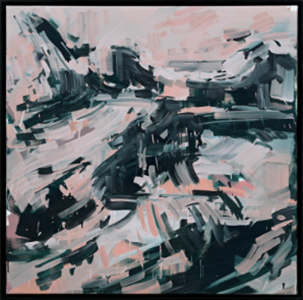
Roman Lipski, Unfinished 3 (1), 2016, 100 cm x 100 cm, acrylic on canvas, photo credits Hans Georg Gaul
AD: Do you work with a technical team?
RL: Yes, I do. To be able to work with my artificial muse I need a team that writes and manages the algorithm. That task takes a lot of time and is very complicated. I am glad Florian Dohmann is with his team from YQP and his company Birds On Mars by my side. In addition, Christina Hooge helps me in my studio. It would be nice in the future to have an algorithm that will be easy to use. So that I could work with it independently, just as other artists could use it for themselves. We make an effort to create a muse for all creative people.
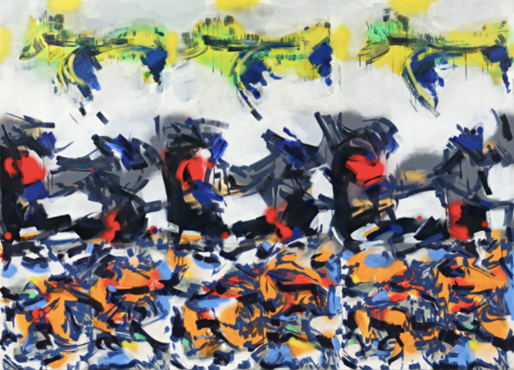 Roman Lipski, Unfinished 5, 2017, 150 cm x 210 cm, acrylic on canvas, photo credits Hans Georg Gaul
Roman Lipski, Unfinished 5, 2017, 150 cm x 210 cm, acrylic on canvas, photo credits Hans Georg Gaul
AD: What is the name of the new -isme – you are setting up?
RL: At the very beginning when we started with the muse, I dreamed with Florian of the future. We want to develop and establish a new style. We don’t know yet what kind of -isme- we will create. But I am sure the name will develop. As spontaneously as it also arose for example for impressionism.
AD: What will be the impact of what you do?
RL: The effects will be that the artist’s approach will change. The working methods change by engaging with artificial intelligence because creativity is experiencing an immense increase. In this case, the artists focus on the creation of their own art and not necessarily on the competition.
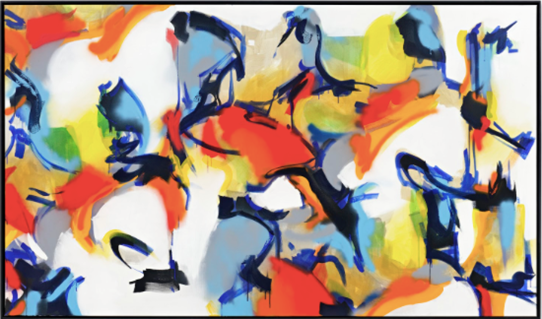 Roman Lipski, Unfinished 6, 2017, 140 cm x 240 cm, acrylic on canvas, photo credits Hans Georg Gaul
Roman Lipski, Unfinished 6, 2017, 140 cm x 240 cm, acrylic on canvas, photo credits Hans Georg Gaul
AD: What Is the future of art?
RL: Art is to be judged according to its own laws, as Victor Cousin 1836 once meant. This is not yet comprehensible but in the future it will be ground-breaking. This is what distinguishes art from design. Artists should push boundaries, create positive utopias and so it should stay. Art should not be political but independent. It must not serve a practical purpose. Art is supposed to consider a different form of thinking. What was already pronounced at that time is - in my view - still the task of art in the future. Additionally, the model of an exhibition must change. We extend our presentations by using new technologies, for example smartphones. This corresponds to the way I work with my artificial muse.
AD: About the art market?
RL: I reject the idea of an art market. Artist create a universal value which has an immense significance for society. The fact that art is treated as a commodity and artists have to sell works their survival - this is a sign that something went wrong. I think the unconditional basic income might be a solution to the problem.
AD: What is your dream project?
RL: My dream project is that I can effort to create an artificial muse for all. And because I am just a human and vain, so I wish to get an exhibition at MoMA in New York.
 Roman Lipski, Untitled, 2018, 110 cm x 150 cm, acrylic on canvas, photo credits Hans Georg Gaul
Roman Lipski, Untitled, 2018, 110 cm x 150 cm, acrylic on canvas, photo credits Hans Georg Gaul
AD: What role does the artist have in society?
RL: Creating art is future-oriented. People do not know what is coming and what is imminent. The artist, however, acts as an autonomous and sensitive dissident who raises questions and examines old ideas and truths critically. He has the task of shaping the future with.
AD: What memorable responses have you had to your projects?
RL: Many artists have expressed a desire to be inspired by an artificial muse, too.
AD: What do you dislike about the art world?
RL: I am particularly disturbed by artists who have forgotten or do not know that art is not purpose-bound. This makes them lose themselves in a pointless competition and become an easy prey for art dealers and false gallery owners.
AD: What role does art funding have?
RL: Art funding has an existential role. The artists are not able to use their full creative potential and at the same time provide for their own livelihood.
AD: What research do you do?
RL: In terms of painting? The source of inspiration has at least doubled since the time of my AI-muse. From time to time I exchange ideas with other artists. Most of all, however, I work with scientists.
 Roman Lipski, Untitled, 2018, 150 cm x 200 cm, acrylic on canvas, photo credits Hans Georg Gaul
Roman Lipski, Untitled, 2018, 150 cm x 200 cm, acrylic on canvas, photo credits Hans Georg Gaul
AD: What’s the best piece of advice you’ve been given?
RL: “Trust yourself.”
AD: What would you have done differently?
RL: I realized too late how important a collaboration is. At the moment I’m about to change it.
[Author] But, where the genius of the human hand strengthens us in our humanity, the machine will lead us only towards the sum of our expectations, quantifiable by Big Data.
This predictability will please most people, but art is something other than immediate gratification. It ritually canalizes the violence that arises from our alienation from the ultimate goal of our existence. Will this wonderful utopia be missed when the reign of the unexplained intention of machines will be established?
In contemporary mass and kitsch art, this absence of a metaphysical dimension will not have a negative impact.
Their aesthetics and their cognitive essence will be decided by the mass of data made available by social media and data banks (Big Data), which companies like Google and Facebook are in the shadow of our invaded privacy.
The computer has no feelings, it only repeats the commands generated by the algorithm
hms of the installed software. His 'Deep Learning' will continue to refine them according to his own parameters.
In a world that is drowned in an overflow of images in search of immediate satisfaction, it is not even the man who will determine what is art, it will be the algorithms of social media.
Thus, like our consumption, the art of mass and the egalitarian beauty of multiculturalism (politically correct) will come out of the machines.

ArtDependence Magazine is an international magazine covering all spheres of contemporary art, as well as modern and classical art.
ArtDependence features the latest art news, highlighting interviews with today’s most influential artists, galleries, curators, collectors, fair directors and individuals at the axis of the arts.
The magazine also covers series of articles and reviews on critical art events, new publications and other foremost happenings in the art world.
If you would like to submit events or editorial content to ArtDependence Magazine, please feel free to reach the magazine via the contact page.